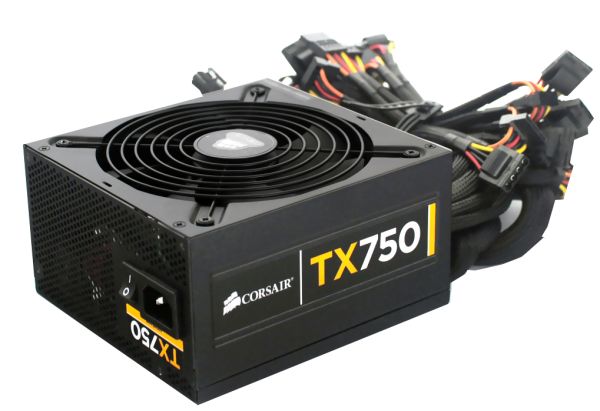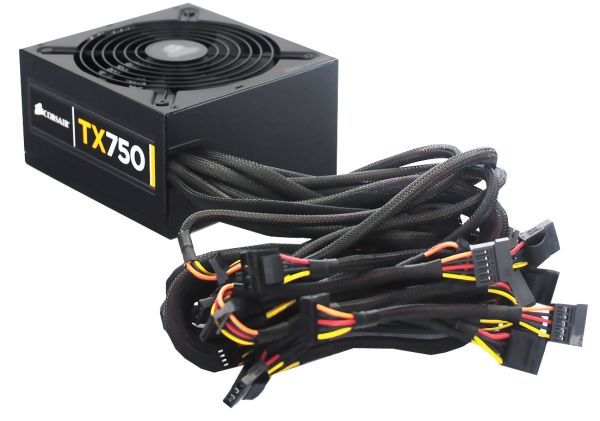Corsair TX750 V2: New and Improved
by Martin Kaffei on May 16, 2011 6:55 PM EST- Posted in
- Cases/Cooling/PSUs
- Corsair
- PSUs
- 80Plus Bronze
- 750W
- TX V2
Appearance, Cables and Connectors
Like the Corsair AX 750W, this model has a simple black finish. On both sides of the PSU there are Corsair logos with the product name. With a usual fan grille and a small power switch it looks "boringly normal" in contrast to Antec's HCG series. The surface is scratch-resistant and those honeycombed ventilation holes at the back are relatively small, which is good for EMI shielding but may hinder airflow slightly.
Corsair has a nicely fashioned hole for the cables exiting the casing, which will protect the black sleeving and cables against damages from rubbing against the case. Cheap power supplies often have sharp-edged outputs that can destroy the sleeving or in some cases even damage the wires, so the protective cover around the edge is appreciated.
The TX750 comes with a large number of fixed cables. You'll want to make sure that your case has enough space to store unused cables, so you don't obstruct the airflow. If your case has a window, the fixed cabling can also look untidy, which is why most users with windows cases prefer modular cables.
| Cables and Connectors | ||
| Fixed | Main | 24-pin 60cm |
| ATX12V/EPS12V | 4+4-pin 60cm | |
| PCIe | 4x 6/8-pin 60cm | |
| Peripheral | 4x SATA 40-85cm / 4x SATA 40-85cm | |
| 4x Molex 40-85cm / 4x Molex 40-85cm (+ FDD adapter 15cm) | ||
The Corsair TX750 V2 has fewer SATA connectors than the Antec HCG 750W, though the length of both mainboard cables (24-pin and 4+4-pin) are equal. Like Seasonic, Corsair offers an FDD adapter in case you need it. In total, the TX750 supports eight SATA and eight Molex connectors, which is more than enough to support most PC configurations. This PSU is also SLI and CrossFire certified.












32 Comments
View All Comments
tomoyo - Monday, May 16, 2011 - link
It's definitely a pretty big improvement, this has been discussed on some other review sites such as jonnyguru. The TX750 v2 is a good seasonic design, the old TX750 is an older cwt design that was not a great performer. This is an awesome budget psu.JarredWalton - Monday, May 16, 2011 - link
I linked in our old TX750 review for comparison; this is a much improved product.Patrick Wolf - Monday, May 16, 2011 - link
So is this review suggesting that it not being a single rail as being a bad thing? Or just that it's specs are incorrect? I mean it's better this way. If it were single rail, the amperage on the +12V would be to high and OCP wouldn't be included, splitting the rails allows for this additional protection. Corsair shouldn't lie to the customer, but I understand why they would as most people still think single rail is superior. At least they're not claming it's multi-rail when the rails are actually combined.Martin Kaffei - Tuesday, May 17, 2011 - link
Just the specs, basically there are no disadvantage for customers. Otherwise the conclusion would have been worse for Corsair. It's still a good PSU.Guspaz - Tuesday, May 17, 2011 - link
No disadvantage, except that consumers now need to worry about balancing rails. Single-rail designs provide the huge benefit of obviating consumers of the need to worry about if they've put too much stuff on one rail instead of the other.Martin Kaffei - Tuesday, May 17, 2011 - link
Nobody needs to worry about the loads. There are just as many connectors as a rail is able to provide. Even if Corsair wants to change something with the configuration the engineers take a look at it first before they sell a single product.erple2 - Tuesday, May 17, 2011 - link
I think there's plenty of research that suggests that a high quality multi-rail PSU is just as good as a high quality single-rail PSU.There are a few exceptions where a single-rail PSU is "better", but that generally refers to instances where you are running a LOT of devices that feed off the 12V rail (10's of harddrives, fancy cooling, 3x+SLI or 3x+ CrossFire, etc).
The other part, however, (truth in advertising) is very important. If' it's a single rail PSU, advertise as such. If it's really a multi-rail PSU, advertise it as such.
Erbadios - Monday, May 16, 2011 - link
That is odd...My manual states that the version 2 of TX 650, 750 and 850 comes with a 140mm fan.
My TX650 v2 does seem to have a very large fan, but i didn't open it to acually check...
So far i like it a lot, it's somewhat quiet. I wonder if the 750TX differs a lot from the 650TX, though..
MeanBruce - Monday, May 16, 2011 - link
The smartest choice you can make is to just wait until this summer when the Corsair Professional Series Platinum debuts. Sure they cost more but well worth it over the 7year warranty period in energy savings alone!;)JarredWalton - Monday, May 16, 2011 - link
Just to do the math:Bronze vs. Platinum: 85% vs. 91% (give or take)
Assume an average daily load of 150W (idle most of the time), and we'll even let the system run 24/7. That works out to:
Bronze: 1547 KWh per year
Platinum: 1429 KWh per year
Assuming $0.10 per KWh, you would save $11.80 per year.
If you actually leave your PC on 24/7 and draw 150W or more, I suppose it could be worthwhile to upgrade to Platinum. Realistically, though, I think Bronze/Silver is more than sufficient. Just my opinion, though.